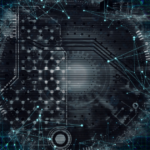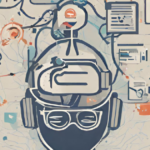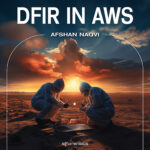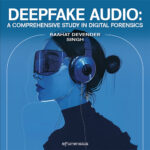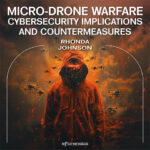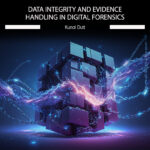No products in the cart.
Interview with Dauda Sule
You must be able to conduct lab exercises for students, particularly in digital forensics, and hold a minimum of a bachelor's degree in cyber security or a related discipline. You would definitely need to be able to demonstrate digital forensics skills with tools such as FTK Imager, Autopsy, and Wireshark, to name a few.
DFIR Labs in the Cloud: The Future of Digital Forensics
In this article, we will cover the ins and outs of adopting cloud solutions in digital forensics and explore how DFIR tools can accommodate this change. As an example, we will look into Belkasoft digital forensics software, known for its innovative solutions, and explore the features that enable it to embrace the cloud approach.
Interview with Barry Grundy
This practical beginner's guide to Linux as a digital forensics platform has been available for over 20 years and has been used by a number of academic institutions and law enforcement agencies around the world to introduce students of DFIR to Linux. Teaching, particularly Linux forensics and open source DFIR tools, is his passion. Barry retired from federal service in 2023, and continues to teach and contribute to the DFIR community where possible.
Tools Used For Space Satellite Forensics
Satellites are crucial in modern communication, navigation, weather forecasting, and national security. As our dependence on satellite technology grows, so does the potential for malicious activities, including hacking and unauthorized access. Space satellite forensics has emerged as a vital field in investigating and mitigating the impact of satellite attacks. In this article, we delve into space satellite forensics, exploring the challenges faced and the tools used to investigate satellite hacking incidents.

SOC Maturity Model
The SOC Maturity Model is a comprehensive framework designed to evaluate and enhance the effectiveness of an organization's Security Operations Center. The SOC Maturity Model provides a systematic approach to benchmark an organization's cybersecurity capabilities, enabling them to understand their current level of maturity and strategically advance their cybersecurity posture.
Unraveling Digital Mysteries: How AI Copilots can Revolutionize Digital Forensic Investigations
Instead of merely focusing on the limitations or potential pitfalls of Large Language Models (LLMs), we ought to explore their promise. Retrieval-Augmented Generation (RAG) is one such promising frontier. By coupling real-time data retrieval with the robust capabilities of generative models, RAG offers a compelling case for the next evolutionary step in digital forensics. This article emphasizes not just the challenges, but also the transformative potential of AI for forensic experts and investigative detectives alike.
How Cyber Threat Intelligence Can Be Utilized to Enhance SOC
This article explores the value of cyber threat intelligence, how it can be used to improve SOC capabilities, and the challenges and considerations a company should consider when it comes to cyber security.
How MITRE ATT&CK Framework Can be Utilized to Enhance The SOC Capabilities
To better identify and defend against threats, cybersecurity professionals can use the MITRE ATT&CK framework, which is a knowledge base of adversary tactics and techniques. A security operations center's (SOC) ability to identify, investigate, and respond to threats can be greatly enhanced by using the MITRE ATT&CK methodology.
Windows Digital Cyber-Crime Forensics Investigation
This article mainly covers a lot about Windows Forensics in-depth and while there are other forensics for operating systems such as iOS, Mac OS and Linux. They’ve not specifically been covered here. There’s even malware analysis which is a broader topic covering each operating system, which I’ll make an article about soon as well. Nonetheless, I hope this article helps you understand more about Windows Forensics and helps you kick-start your journey in investigating cyber-crime in the Windows world.
Interview with Chirath De Alwis
I would like to identify myself as a person who loves doing research in the cybersecurity domain and also loves sharing my knowledge and research findings with the community for the betterment of the community.
Breaking Weak Implementations of VPN Encryption and the Role of Entropy Levels
Weak implementations of VPN encryption can expose vulnerabilities that malicious actors can exploit, compromising the very security they are intended to provide. In this article, we delve into the intricacies of breaking weak implementations of VPN encryption and explore the pivotal role that entropy levels play in bolstering cryptographic strength.
Cryptography and the Frontier of Privacy
This article seeks to provide an in-depth exploration of the applications of cryptography in the context of cybersecurity. We'll cover a variety of complex and essential topics, including symmetric and asymmetric key cryptography, encryption algorithms, authentication protocols, digital signatures, and key management. In addition, we will examine practical use cases where encryption plays a critical role in mitigating cyberthreats, such as man-in-the-middle attacks, data tampering, and identity theft, and the contradictions with GDPR and LGPD regulations that have angered governments and law enforcement.
AI-Driven Analysis in Digital Forensics: Uncovering Patterns from Pixels
Digital forensics has become a crucial discipline in solving cybercrimes and uncovering digital evidence in today's ever-evolving landscape of technology and crime. As the volume and complexity of digital data continues to grow, traditional investigative methods are being challenged. However, artificial intelligence (AI) has emerged as a game-changing force that is transforming the field of digital forensics. In this article, we will delve into the world of AI-driven analysis and explore how it is reshaping the way investigators approach digital evidence and solve complex cases.
Interview with Brett Shavers
Brett Shavers is a former law enforcement detective and currently is a digital forensics consultant to law firms in civil litigation along with an occasional government engagement in high profile investigations. Brett has been assigned to local state, and federal task forces working all types of cases, including international and national security matters.
Forensic Fun with Cryptographic DataFrames using Python
This is a journey into clever and interesting ways to apply cryptographic DataFrames 1 for forensic/anti-forensic purposes using Python3. You'll learn to work with cryptographic DataFrames for interesting ulterior motives using Python3.
Cyber Threat Intelligence 101
Dear readers, I conclude our journey here with the following thoughts: threat intelligence should provide context to support decision-making, help machines and humans work better together, and provide threat intelligence is for everyone. I hope to have opened a range of study possibilities, feel free to choose your favorite topic and delve deeper. I leave some reading suggestions in the references.
Satellite Forensics
Satellites have become indispensable elements of modern-day life. This technology is playing a vital role in communication, navigation, streaming services, Earth observation, and scientific research. As our dependence on satellite technology grows, the number of vulnerabilities grows with it; so does the need for satellite forensics, a specialized field focused on gathering and analyzing data from satellites to investigate incidents, such as space debris collisions, unauthorized access, or security breaches.
DFIR Labs in the Cloud: The Future of Digital Forensics
In this article, we will cover the ins and outs of adopting cloud solutions in digital forensics and explore how DFIR tools can accommodate this change. As an example, we will look into Belkasoft digital forensics software, known for its innovative solutions, and explore the features that enable it to embrace the cloud approach.
Cryptography and Cybersecurity Paramount Challenges
Modern cryptography played a key role during World War II, especially with the encoding of German messages by the Enigma machine. However, since 1932, the important work of Polish cryptologist Marian Rejewski, who used statistical analysis to break Enigma's encryption, contributed to the cracking of this cryptographic system by Alan Turing and his team. These days, encryption helps protect data in a variety of business and government endeavors.
Using AI to Break the Authentication Process
This article highlights the need to adopt an Artificial Intelligence (AI) awareness and discusses some devices used by criminal agents to break protection authentication and security barriers and then access Information Systems or resources.
Unlocking the Orbital Domain: Digital Forensics in Satellite and UAV Technologies
The evolution of digital technology has significantly broadened the scope of digital forensics, a field traditionally tethered to terrestrial digital systems. The advent of satellite and Unmanned Aerial Vehicle (UAV) technologies has opened up new frontiers, marking a significant stride towards a global digital ecosystem. These technologies are the linchpins in a gamut of critical sectors including global communication, navigation, and surveillance. The imperative to safeguard these systems against burgeoning cyber threats has catalyzed the emergence of satellite and UAV digital forensics. This discourse endeavors to traverse the nascent field of satellite and UAV digital forensics, elucidating on the symbiotic relationship between emerging digital forensic tools, methodologies, and the inherent challenges.
Tools Used For Space Satellite Forensics
Satellites are crucial in modern communication, navigation, weather forecasting, and national security. As our dependence on satellite technology grows, so does the potential for malicious activities, including hacking and unauthorized access. Space satellite forensics has emerged as a vital field in investigating and mitigating the impact of satellite attacks. In this article, we delve into space satellite forensics, exploring the challenges faced and the tools used to investigate satellite hacking incidents.
Unlocking Mysteries Beyond Earth from Above: The World of Satellite
Satellites, sometimes called “Digital Television”, orbiting high above the Earth's atmosphere, have become essential tools for communication, navigation, weather monitoring, and national security, but there are also natural satellites. For example, Earth is a satellite because it orbits the sun, and the moon is a satellite because it orbits the Earth. Figure 1 shows the typical satellite architecture. Dotted orange arrows denote radio links; solid black arrows denote ground network links. While their main functions are recognized, they also play a vital role in forensic investigations, helping unravel mysteries from above and provide valued insights into numerous events and occurrences. Satellite forensics, a quite promising field, involves the investigation and analysis of satellite images and data to track information pertinent to legal and investigative processes.
Interview with Dauda Sule
You must be able to conduct lab exercises for students, particularly in digital forensics, and hold a minimum of a bachelor's degree in cyber security or a related discipline. You would definitely need to be able to demonstrate digital forensics skills with tools such as FTK Imager, Autopsy, and Wireshark, to name a few.
Interview with Kunal Dutt
In myriad cases, digital forensics comes into the picture, but the most generic answer would be “when the cyber security infrastructure fails somewhere around the cause of vulnerabilities, to identify and trace down the entire incident of this failure would be a process done by this glorious department known as digital forensics“
Incident Response and Forensics Foundamentals in AWS - LIVE WEBINAR with Afshan Naqvi
Welcome to the first live webinar by eForensics Magazine. My name is Bartek and I'm responsible for organizing online courses, mostly for PenTest Magazine and for Hackin9 Magazine, but also the most recent course of eForensics, which is instructed by Ms. Afshan Naqvi, who is present with us today.
Interview with Dauda Sule
You must be able to conduct lab exercises for students, particularly in digital forensics, and hold a minimum of a bachelor's degree in cyber security or a related discipline. You would definitely need to be able to demonstrate digital forensics skills with tools such as FTK Imager, Autopsy, and Wireshark, to name a few.
DFIR Labs in the Cloud: The Future of Digital Forensics
In this article, we will cover the ins and outs of adopting cloud solutions in digital forensics and explore how DFIR tools can accommodate this change. As an example, we will look into Belkasoft digital forensics software, known for its innovative solutions, and explore the features that enable it to embrace the cloud approach.

DFIR in AWS (W63)
This course provides a crucial skill set in securing AWS environments. In today's digital landscape, understanding digital forensics, incident response, and automation in AWS is essential for safeguarding data and infrastructure. This course offers hands-on experience, making it an invaluable asset for those eager to enhance their cybersecurity expertise and stay ahead in the dynamic field of cloud security.
Deepfake Audio: A Comprehensive Study in Digital Forensics Course Online (W62)
This course is aimed at presenting an elementary yet comprehensive picture of the field of digital audio forensics, with the implied hope that it will afford the participant useful theoretical and practical knowledge of the field and its various aspects.
Micro-drone Warfare: Cybersecurity Implications and Countermeasures (W61)
"Micro-drone Warfare: Cybersecurity Implications and Countermeasures" is an advanced course designed for digital forensics professionals seeking to understand the cybersecurity challenges posed by the increasing use of micro-drones in modern warfare. The course provides an in-depth exploration of micro-drone technologies, their role in cyber threats, and the countermeasures necessary to mitigate these threats. Learners will delve into the various types and capabilities of micro-drones, their communication and networking technologies, and the associated cybersecurity vulnerabilities. The course covers risk assessment and threat modeling for micro-drone systems, analysis of real-world micro-drone warfare scenarios, and the development of defense strategies against potential cyber attacks. Additionally, the course addresses the legal and policy frameworks governing micro-drone warfare cybersecurity, including ethical considerations, privacy implications, and international regulations. The course is led by Rhonda Johnson, a seasoned educator and Ph.D. student specializing in Cybersecurity. Prior knowledge of computer networks, cybersecurity principles, operating systems, basic electronics, and wireless communication is recommended. The course employs tools such as Drone Simulators and Drone Performance Evaluation Tools for practical learning.
Data Integrity And Evidence Handling in Digital Forensics - Course Online (W60)
The course is intended for individuals from the IT industry as well as those outside of it who have some knowledge of cybersecurity. Basic concepts of cybersecurity are required. During the course, participants will acquire skills related to: Understanding digital forensics, including its scope, relevance in investigations, and legal and ethical considerations. Concepts of data integrity and its significance in digital forensics. They will learn about various threats to data integrity and techniques for ensuring its preservation throughout the forensic process. Principles of evidence handling, including chain of custody, documentation, and the importance of maintaining the integrity of evidence. Legal and ethical considerations related to digital evidence handling. This includes understanding privacy and confidentiality considerations and the role of expert witness testimony in courtroom presentations. Data acquisition techniques for different types of digital devices. They will learn about disk imaging, integrity verification, and the use of hash functions in maintaining data integrity. Techniques for analyzing and examining digital evidence, including file system analysis, data recovery, reconstruction techniques, and metadata analysis. The course also includes practical application of various tools and technologies used in digital forensics, such as Autopsy, The Sleuth Kit (TSK), Volatility, Plaso, Wireshark, Bulk Extractor, OSForensics, and Autopsy Browser. At the end of the course, a final exam is planned consisting of multiple-choice questions on the concepts and fundamentals arising from the course outcomes, along with practical tasks.

